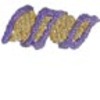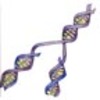

Genetics is the science of genes and heredity. Inside the nucleus of all your body cells are 23 pairs of chromosomes. Each chromosome carries hundreds to thousands of genes on it. Each gene describes some of your traits. Your hair color, eye color, allergies, body shape, how smart you are, your health, tastes, and on and on. These are all traits described by your genes. The genes describe these traits with a kind of code - a genetic code. The genetic code is found on a double strand all wound around on itself, called, DNA. Heredity is how we pass these coded traits on to our children.
One April 24, 2003, scientists at the National Human Genome Research Institute (NHGRI) and the US Department of Energy (DOE) announced that they had completed the sequencing of the human genome, 50 years to the day that Nobel Prize winners James Watson and Francis Crick published the molecular structure of the DNA double helix. The decoding of the 3 billion DNA letters of the human genome is the result of one of the most ambitious scientific projects of all time, comparable to going to the moon and splitting the atom. This amazing achievement was accomplished by The International Human Genome Sequencing Consortium and included hundreds of scientists at 20 sequencing centers in the United States, Great Britain, China, France, Germany, Japan and China. These scientists recognized that the sequence of the human genome belonged to every human being and placed all of the sequence generated by the Human Genome Project into public databases freely available to scientists around the world with no restrictions on its use.
NGSS - Next Generation of Science Standards
LS3 Heredity: Inheritance and Variation of Traits:
LS3.A Inheritance of Traits
K-2 Young organisms are very much, but not exactly, like their parents and also resemble other organisms of the same kind.
3-5 Different organisms vary in how they look and function because they have different inherited information; the environment also affects the traits that an organism develops.
6-8 Genes chiefly regulate a specific protein, which affect an individual’s traits.
9-12 DNA carries instructions for forming species’ characteristics. Each cell in an organism has the same genetic content, but genes expressed by cells can differ.
LS3.B Variation of Traits
K-2 N/A
3-5 N/A
6-8 In sexual reproduction, each parent contributes half of the genes acquired by the offspring resulting in variation between parent and offspring. Genetic information can be altered because of mutations, which may result in beneficial, negative, or no change to proteins in or traits of an organism.
9-12 The variation and distribution of traits in a population depend on genetic and environmental factors. Genetic variation can result from mutations caused by environmental factors or errors in DNA replication, or from chromosomes swapping sections during meiosis.































